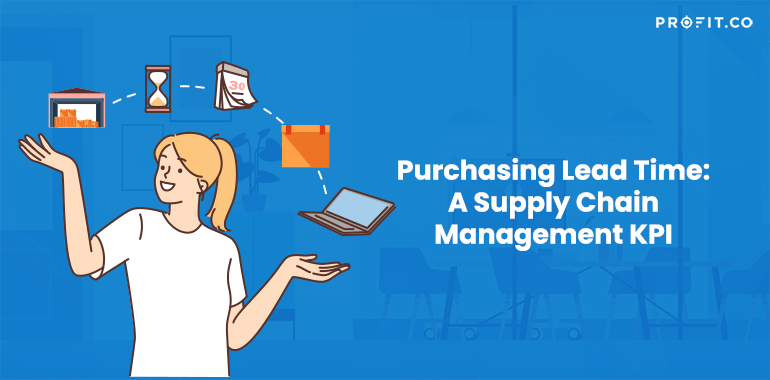Introduction
In the intricate world of supply chain management, every second counts. Time is money; perhaps no metric illustrates this more vividly than the Purchasing Lead Time. Purchasing lead time is critical to customer satisfaction, operational efficiency, and business profitability.
This seemingly straightforward concept of the duration between placing an order and its final readiness for use or sale can have an astronomical impact on a business. Misjudge it, and you could be staring at a logistical nightmare of stockouts, overstock, or aggravated customers. Nail it, and you have a well-oiled supply chain, minimum inventory costs, and a customer base that can rely on your timely delivery.
In this blog, we will dive deep into purchasing lead time, its pivotal role in your supply chain, the formula for its calculation, and how best to manage and optimize it. So whether you’re a seasoned business owner, a procurement professional, or a startup founder stepping into the exciting world of inventory management, there’s something to glean for everyone.
Be a yardstick of quality. Some people aren’t used to an environment where excellence is expected.
What is Purchasing Lead Time?
Purchasing lead time, also known as supplier lead time, is an essential metric in supply chain management and supply inventory management. It is the time that elapses from when a company places an order with a supplier until the goods are received and ready for use or resale.
This timeframe encapsulates several stages:
- Order Preparation Time: The duration needed to prepare a purchase order once the need for a particular product is identified.
- Supplier Processing Time: The time the supplier takes to process, prepare, and pack the goods for dispatch after receiving the order.
- Transit Time: The period for goods transported from the supplier’s location to your business.
- Receiving and Inspection Time: The time is taken to unload, inspect, and transfer the goods into your warehouse or storage.
Understanding and accurately estimating purchasing lead times is critical for businesses as it influences inventory levels, carrying costs, and customer satisfaction. If purchasing lead times are longer than anticipated, it may lead to stockouts and missed sales opportunities. Conversely, if lead times are shorter than estimated, it can result in overstocking and increased holding costs.
Given the importance of this metric, businesses often work towards reducing their purchasing lead time by implementing strategies like improving supplier relationships, adopting advanced inventory management systems, and using predictive analytics to forecast demand and supply timelines better.
Formula
While there is not a universally accepted formula for calculating purchasing lead time, it’s typically determined by adding the various time frames associated with each step of the procurement process, from the moment the order is placed until the goods are received and ready for use.
Here’s how you might break it down:

Each of these times can vary based on the supplier, the type of goods being ordered, shipping methods, and internal processes at your business.
It’s crucial to note that many factors can influence lead time and may only sometimes be consistent. As a result, businesses often calculate an average lead time based on historical data to account for variability.
Please remember the more accurately you can calculate your lead time, the more effectively you can manage inventory and prevent both stockouts and excess stock.
Example
Imagine owning a boutique that sells handmade leather goods, and you’ve just ordered 100 leather wallets from your supplier.
Here’s how the lead time breaks down:
Order Preparation Time: It takes 1 day to finalize the details and send the purchase order to your supplier.
Supplier Processing Time: Your supplier takes 5 days to process the order, manufacture the wallets, and prepare them for shipping.
Transit Time: The shipping company takes 3 days to transport the wallets to your boutique from the supplier’s location.
Receiving and Inspection Time: Once the wallets arrive, it takes your team 1 day to check them for quality and to add them to your inventory system.
Add all these times together to get the total purchasing lead time:
Purchasing Lead Time = 1 (Order Preparation Time) + 5 (Supplier Processing Time) + 3 (Transit Time) + 1 (Receiving and Inspection Time) = 10 days
In this example, your Purchasing Lead Time is 10 days. This means that from when you decide to order more wallets to when they are on your shelves ready for sale, you can expect it to take about 10 days.
Knowing this, you can plan your inventory management accordingly to prevent stockouts and ensure you can meet customer demand.
Don’t leave your business success to chance – start measuring your KPIs and take control of your performance!
Benefits of Utilizing Purchasing Lead Time
Understanding and effectively managing Purchasing Lead Time is crucial for a business’s success. Businesses can use feedback evaluation through customer feedback and internal assessments to measure the success of their efforts in managing Purchasing Lead Time.
Here are some of the key benefits associated with a good handle on purchasing lead time:
1. Better inventory management
Purchasing lead time helps accurately predict when new stocks will be available for sale. It enables a company to optimize inventory levels, reducing stockouts (which can lead to lost sales) and overstocking (which can inflate storage costs).
2. Improved cash flow management
Knowing your lead times, you can better plan when to pay suppliers, leading to optimized cash flow management.
3. Enhanced customer satisfaction
Knowing when you can expect products to arrive, you can provide more accurate delivery dates to your customers, enhancing their experience and boosting satisfaction.
Strategies for Managing Purchasing Lead Time
Effectively managing purchasing lead time is vital to maintain smooth operations, fulfilling customer orders on time, and reducing inventory costs.
Here are some strategies businesses can use to manage and reduce their purchasing lead time:
1. Build strong supplier relationships
Strong relationships with suppliers can help you negotiate better lead times. Regular communication, feedback, and long-term contracts can improve reliability and reduce uncertainties.
2. Use accurate demand forecasting
Advanced forecasting tools can help predict future demand accurately, allow for more strategic ordering and help prevent rush orders that can extend lead times.
3. Maintain a safety stock
Keeping a buffer stock can help manage longer lead times and prevent stockouts. However, this needs to be balanced against the extra inventory costs.
4. Consider multiple suppliers
Relying on a single supplier is not a sound strategy. Multiple suppliers can provide alternatives if one supplier cannot meet the desired lead time.
5. Leverage technology
Supply chain management software can provide real-time tracking, automated ordering, and analytics to help manage lead times.
By using these strategies, businesses can gain more control over their purchasing lead time, helping them to manage inventory more effectively, meet customer expectations, and enhance operational efficiency. Businesses can set specific supply chain OKRs related to lead time reduction and supply chain efficiency to drive improvements in their overall performance.
Conclusion
Navigating the complexities of supply chain management can be daunting, but understanding and effectively managing your purchasing lead time can smooth out many potential bumps in the road. Purchasing lead time is critical in inventory management, operational efficiency, and customer satisfaction by demystifying purchasing lead time.
In a rapidly evolving business landscape, the margin for error is slim, and the cost of inefficiency can be high. Profit.co provides versatile and intuitive OKR management software for your business’s needs and helps you track your purchasing lead time seamlessly.
The journey toward understanding and optimizing your purchasing lead time can be challenging, but the rewards are well worth the effort. And remember, in supply chain management, time is not just money; it’s also reputation, reliability, and resilience.

